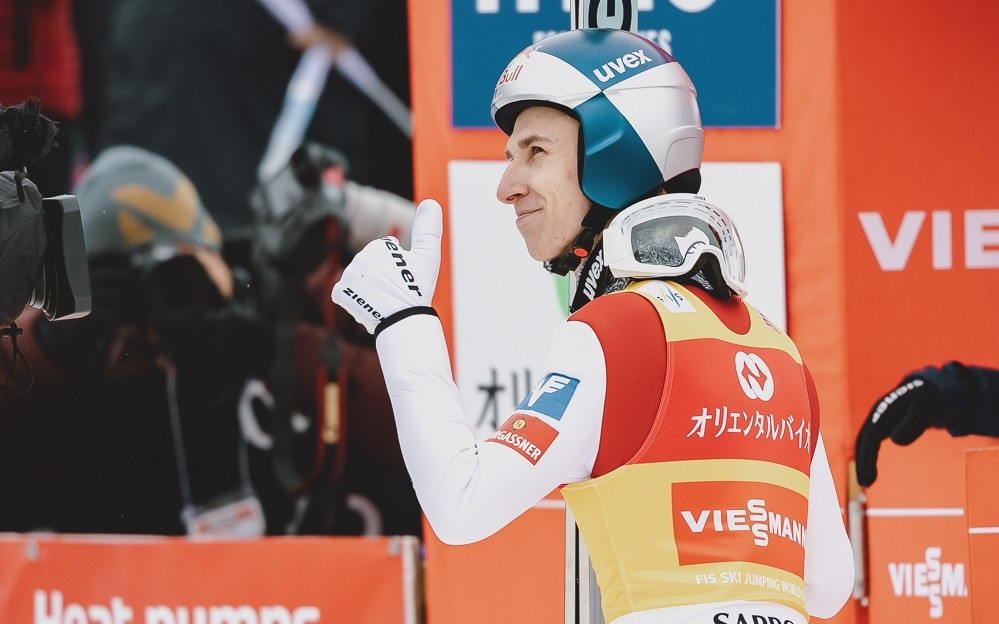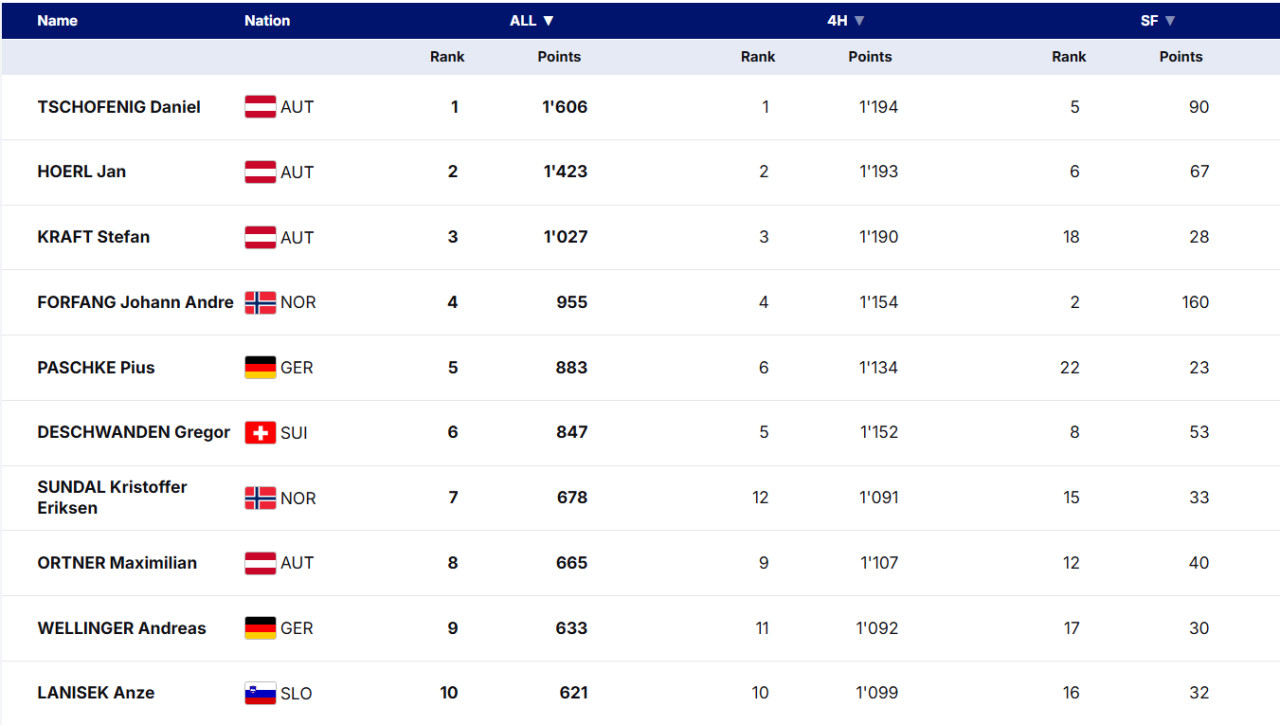Switzerland shines at the World Championships while Shiffrin struggles in the slalom. Here’s a recap of the week in skiing.
Ski Jumping
Upcoming Events:
Sapporo (Japan), HS 137, individual competition
Sunday, February 16
Sapporo (Japan), HS 137, individual competition
Ryo Kobayashi's Winning Double in Sapporo
The Ski Jumping World Cup moved to Sapporo for the last stage before the World Championship, and the weekend in Japan delivered an unexpected result – a winning double by the host, Ryo Kobayashi.
The star Japanese jumper has had a notably disappointing season. After missing the stage in Zakopane and a training camp at home, Ryo made some progress, but no one anticipated the performance he displayed in Sapporo. Particularly since on Saturday, he not only won but crushed his competitors with a 19.7-point advantage over the nearest rival. The Sunday victory marked Kobayashi’s 34th in his World Cup career, surpassing Jens Weissflog and propelling him to seventh place in history.
Regardless, Kobayashi's performance significantly alters the pre-race dynamics for the World Championship in Trondheim. What is the secret to Ryo's dominance – the home advantage or a sudden improvement? Since the Sapporo stage was the last before the World Championship, we will find out the answer directly in Trondheim. However, the fact that Kobayashi has reached the podium in eight consecutive individual World Cup events in Sapporo suggests that the home advantage is definitely a factor.
 9
9Saturday’s event in Sapporo was successful not only for Kobayashi but also for the entire Japanese team. Besides Ryo, Ren Nikido and Naoki Nakamura also made it into the top 10. It was the first time since November 20, 2021 (Nizhny Tagil) that three Japanese athletes finished in the top ten in a single World Cup event.
A lot of attention was focused on the legendary Noriaki Kasai – the 52-year-old veteran made it into the national team group and once again broke his own record as the oldest participant in World Cup history. Unlike last year, this time Kasai disappointed. On Friday, he failed to qualify, and on Sunday, he finished a modest 45th.
Such results eliminate Nori’s chances of competing in the World Championship and the March stages of the World Cup. Nevertheless, in an interview with Polish media, Kasai stated he does not plan to retire and aims to compete in the 2026 Olympics.
Marius Lindvik had his best weekend of the season, which has been marked by instability. In paired World Cup stages, he usually performs much better on Sundays than on Saturdays. However, in Sapporo, he delivered two excellent performances: 5th and 2nd places. The Sunday podium was Lindvik's first of the current season.
On the other hand, Johann André Forfang, after a strong series of performances over the last month and a half, experienced his first setback in Sapporo on Saturday with only a 27th place in the first round. In the second round, the Norwegian climbed to 14th place, but this result is still unsatisfactory in terms of competing for a top-3 finish in the overall World Cup standings. The slip in the first attempt can partly be attributed to unfavorable wind conditions, especially considering that wind adjustments in Sapporo often do not reflect the actual state of affairs.
Robin Pedersen made waves in Sapporo, winning the first training session on Friday with an incredible jump of 152.5 meters – an unofficial record for "Okurayama." He proved that jump was no fluke on Saturday, finishing 12th. For the 28-year-old Norwegian, this is his best result in the World Cup since March 2020.
Domen Prevc loves the Sapporo hill, having won here last year. This time, the Slovenian finished third on Saturday and held the same position after the first attempt of the Sunday competition. However, in the second round, Domen dropped to an overall 8th place.
Tim Zajc had a disappointing return to the World Cup after missing the stage in Lake Placid, finishing only 39th in Saturday's event. On Sunday, the Slovenian showed the second-best result in qualification and rounded out the top 10 in the main competition, but this result does not clarify why Tim took a break from competing and whether missing the Lake Placid stage benefited him.
The Austrian team left the podium empty on Sunday – this has happened only twice this season. Daniel Tschofenig finished fourth twice, and the only podium the team led by Andreas Widholz secured over two days was Jan Hörl's second place on Saturday. Regardless, it was officially announced after the Sapporo stage that the holder of the Big Crystal Globe this season will be an Austrian. Tschofenig, Hörl, and Stefan Kraft occupy the top three spots, while the rest of the competitors have already lost even mathematical chances of catching up with the current holder of the yellow bib.
 0
0The German team continues to struggle. Andreas Wellinger broke the team’s terrible streak of six consecutive individual World Cup starts without a top-10 finish with his 9th place on Sunday, but on Saturday, none of the Germans even made it into the top 20! In this event, Stefan Horngacher's charges scored fewer points in the Nations Cup than teams like France or Estonia.
Pius Paschke's return after missing the stage in Lake Placid cannot be called successful. Although he had decent jumps in training, his 23rd and 31st places in the main events are a failure. However, it should be noted that the Germans’ Saturday fiasco can be partly attributed to the fact that both Paschke and Wellinger were clearly unlucky with the weather conditions. Although this does not negate the fact that the German team is approaching the World Championship in a deep crisis.
The Polish team is also facing challenges. During the Sapporo stage, the sports director of the ski jumping and Nordic combined department of the Polish Ski Association, Alexander Stöckl, announced in an interview with Norwegian media that he is leaving his position. The Austrian claims that the reason for this decision is poor relations with the head of the Association, the legendary Adam Małysz. Stöckl asserts that behind Małysz's back, he regularly expressed dissatisfaction with Alexander's work, but never dared to confront him face-to-face.
Kamil Stoch returned to the World Cup after a three-week break. The legendary Pole performed decently (22nd and 16th places), but his inclusion in the team for the World Championship is still in serious doubt.
The Swiss team had a rocky start in Sapporo. During the flight, all of the team’s luggage somehow ended up in Helsinki, so for the first two days, Rune Velta's team had to compete with borrowed equipment: skis from the Japanese and bindings from the Poles. The team leader, Gregor Deschwanden, struggled under such stressful circumstances, finishing only 17th and 28th.
11th on Saturday was Artti Aigro. The Estonian was just 0.2 points away from his second career top-10 finish in the World Cup. After a disappointing first half of the season, Alex Insam is regaining his form from last year. In Sapporo, the Italian finished 15th and 19th.
Overall World Cup Standings:
 1
1Nations Cup:
 2
2Alpine Skiing
Upcoming Events:
Friday, February 14
World Championship 2025, Saalbach-Hinterglemm (Austria), Giant Slalom, Men
Saturday, February 15
World Championship 2025, Saalbach-Hinterglemm (Austria), Slalom, Women
Sunday, February 16
World Championship 2025, Saalbach-Hinterglemm (Austria), Slalom, Men
Switzerland's Slalom Showcase, Shiffrin Without a Medal
The women's championship program concluded with the slalom, which had a major intrigue surrounding Mikaela Shiffrin's condition. Leading up to the championship, the star American approached with just one race in the World Cup after her injury – a 10th place in the slalom in Courchevel on January 30. Directly in Saalbach, Shiffrin changed her plans on the fly, opting out of the giant in favor of the team combined, which she raced alongside Breezy Johnson.
Mikaela's performance on Tuesday left a decidedly mixed impression. On one hand, she and